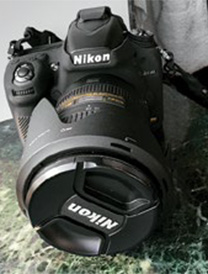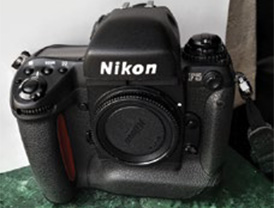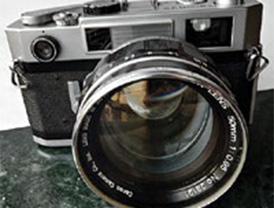
As a young kid, I watched with amazement my father taking photographs with a folding plate film camera, and then colouring the prints with a paint brush. The camera was a pre-war Goertz made by C.P. Goertz and Co. (now defunct).
My elder brother (elder by six years) inherited the camera, and in the fifties it was still possible to find a photo store who would cut and load film in the plate film cartridge. Meanwhile, a Kodak 620 box camera was handed down to us which was the epitome of simplicity. Load the camera with 620 film which gave eight negatives, and point and shoot! Depending on how the camera was held, you got a portrait or landscape type photo. The results were pretty good for such a basic camera, and several birthdays and family outings were recorded with it.
Looking for some more sophistication, my brother bought a second hand Rolleiflex T Model twin lens camera, which took a 120 size film. I would borrow it most of the time, and finally he gifted it to me. Film was affordable at Rs.5 per roll.

 With the passage of time and the growth of my income, I decided to change to a SLR camera, and the most affordable one in 1972 was an Asahi Pentax Spotmatic camera which came for Rs.2000, still a princely sum, from a dealer in cameras brought in by persons on a transfer of residence. It was a time of strict import controls and one had to scrounge for lens and accessories which were also not available freely.
With the passage of time and the growth of my income, I decided to change to a SLR camera, and the most affordable one in 1972 was an Asahi Pentax Spotmatic camera which came for Rs.2000, still a princely sum, from a dealer in cameras brought in by persons on a transfer of residence. It was a time of strict import controls and one had to scrounge for lens and accessories which were also not available freely.
This camera served me well for several years, until I decided to buy a second hand Minolta SRT 101 which was built like a rock, and weighed like a rock. Lots of pictures later, and with some more money in the pocket, I decided to buy a Nikon F3 camera, as it was also a status symbol at the time.
I used this one on all my travels, and finally traded it for an almost brand new Nikon F5, which I still possess. Another rock of a camera, tough and reliable, which eventually gave way to the digital era with the purchase of the Nikon D200.
Somewhere along the way, a well-known camera repairer Sardarji (a thorough gentleman, and now deceased), offered me a Canon rangefinder camera which came with a 50 mm f/0.95 lens, in brand new condition This camera used an exposure meter using nickel cadmium batteries, which were subsequently discontinued, because of their high mercury content. I think that this lens is probably still the fastest lens ever made.
In between, there was a fad for collecting Leica rangefinder cameras and their lens. Loading film in a Leica was tricky business and required some skill. Also, since their lenses which were made in the 1950’s and 1960’s used a bonding agent for holding together the lens elements, the lens became opaque with the passage of time and lost their sharpness. Still, there being a ready market for second hand Leica cameras (and surprisingly from Japanese buyers), I managed to sell my Leica M3, M2 and MD 4 camera bodies and their lens for a profit, which was invested in buying the Nikon lens that I wanted.
Today, after several tradeins between friends and dealers, I now possess a Nikon D 750 SLR, which is another superlative camera. However, with age catching up with me, I find it heavy and cumbersome to travel with it, and so the camera I now use the most is a recently acquired Panasonic TZ 100 camera, which does almost everything an SLR can do, without dislocating my shoulder, and it can be carried in a pouch on my belt.

 As a hobby, photography has given me immense pleasure and has also helped me to make lasting contacts with other enthusiasts.
As a hobby, photography has given me immense pleasure and has also helped me to make lasting contacts with other enthusiasts.
Do I have any regrets? Yes. In the 1960s till the 1980s I used colour slide film, since projecting a slide on a screen brought out the best in a photograph, which a print could never do. Sadly, almost all of my slides and the memories recorded thereon were destroyed with fungus eating into the film. Today, it is only the black and white pictures which have survived over the years, and even the colour prints have their colours fading.
In conclusion, I urge anybody taking up this hobby to start with the simplest camera, like I did, before moving on to expensive and sophisticated models; otherwise frustration may result with the many options cameras now come with, leaving one to give it all up. |SP

